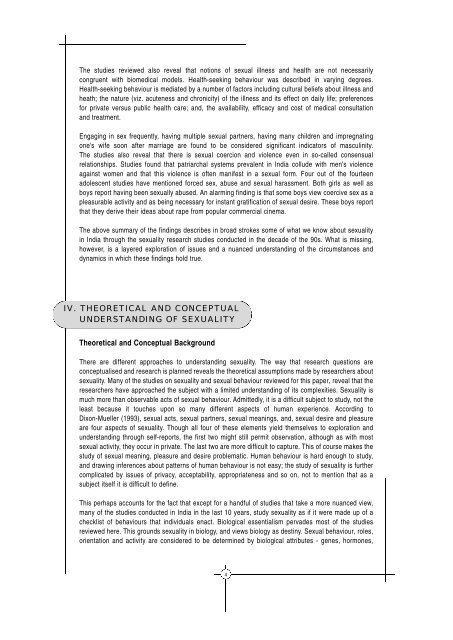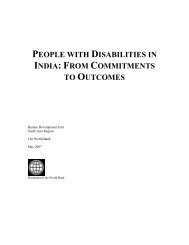FREE Download - TARSHI
FREE Download - TARSHI
FREE Download - TARSHI
You also want an ePaper? Increase the reach of your titles
YUMPU automatically turns print PDFs into web optimized ePapers that Google loves.
The studies reviewed also reveal that notions of sexual illness and health are not necessarily<br />
congruent with biomedical models. Health-seeking behaviour was described in varying degrees.<br />
Health-seeking behaviour is mediated by a number of factors including cultural beliefs about illness and<br />
heath; the nature (viz. acuteness and chronicity) of the illness and its effect on daily life; preferences<br />
for private versus public health care; and, the availability, efficacy and cost of medical consultation<br />
and treatment.<br />
Engaging in sex frequently, having multiple sexual partners, having many children and impregnating<br />
one's wife soon after marriage are found to be considered significant indicators of masculinity.<br />
The studies also reveal that there is sexual coercion and violence even in so-called consensual<br />
relationships. Studies found that patriarchal systems prevalent in India collude with men's violence<br />
against women and that this violence is often manifest in a sexual form. Four out of the fourteen<br />
adolescent studies have mentioned forced sex, abuse and sexual harassment. Both girls as well as<br />
boys report having been sexually abused. An alarming finding is that some boys view coercive sex as a<br />
pleasurable activity and as being necessary for instant gratification of sexual desire. These boys report<br />
that they derive their ideas about rape from popular commercial cinema.<br />
The above summary of the findings describes in broad strokes some of what we know about sexuality<br />
in India through the sexuality research studies conducted in the decade of the 90s. What is missing,<br />
however, is a layered exploration of issues and a nuanced understanding of the circumstances and<br />
dynamics in which these findings hold true.<br />
IV. THEORETICAL AND CONCEPTUAL<br />
UNDERSTANDING OF SEXUALITY<br />
Theoretical and Conceptual Background<br />
There are different approaches to understanding sexuality. The way that research questions are<br />
conceptualised and research is planned reveals the theoretical assumptions made by researchers about<br />
sexuality. Many of the studies on sexuality and sexual behaviour reviewed for this paper, reveal that the<br />
researchers have approached the subject with a limited understanding of its complexities. Sexuality is<br />
much more than observable acts of sexual behaviour. Admittedly, it is a difficult subject to study, not the<br />
least because it touches upon so many different aspects of human experience. According to<br />
Dixon-Mueller (1993), sexual acts, sexual partners, sexual meanings, and, sexual desire and pleasure<br />
are four aspects of sexuality. Though all four of these elements yield themselves to exploration and<br />
understanding through self-reports, the first two might still permit observation, although as with most<br />
sexual activity, they occur in private. The last two are more difficult to capture. This of course makes the<br />
study of sexual meaning, pleasure and desire problematic. Human behaviour is hard enough to study,<br />
and drawing inferences about patterns of human behaviour is not easy; the study of sexuality is further<br />
complicated by issues of privacy, acceptability, appropriateness and so on, not to mention that as a<br />
subject itself it is difficult to define.<br />
This perhaps accounts for the fact that except for a handful of studies that take a more nuanced view,<br />
many of the studies conducted in India in the last 10 years, study sexuality as if it were made up of a<br />
checklist of behaviours that individuals enact. Biological essentialism pervades most of the studies<br />
reviewed here. This grounds sexuality in biology, and views biology as destiny. Sexual behaviour, roles,<br />
orientation and activity are considered to be determined by biological attributes - genes, hormones,<br />
4










